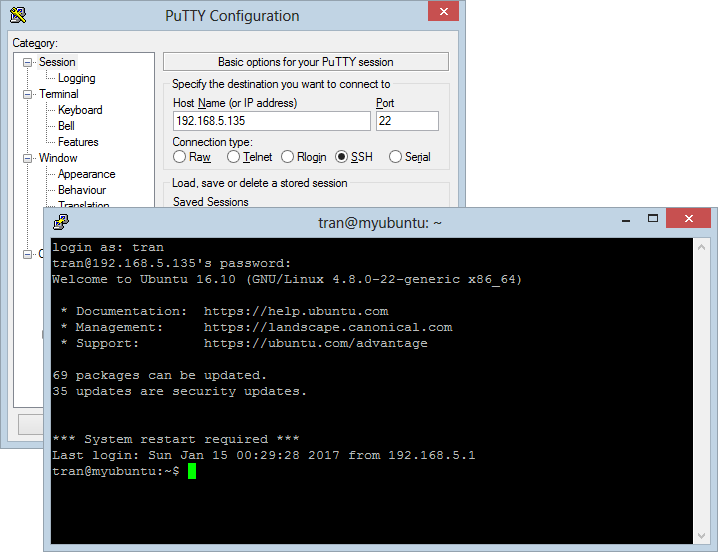ITerm2 is a replacement for Terminal and the successor to iTerm. It works on Macs with macOS 10.14 or newer. ITerm2 brings the terminal into the modern age with features you never knew you always wanted. Why Do I Want It? Check out the impressive features and screenshots. If you spend a lot of time in a terminal, then you'll appreciate all the. I noticed macOS Sierra resetted my X11 settings so that it disabled my xAuth program. To re-enable xAuth on macOS Sierra: Reinstall X11/xQuartz to presumably reset any changes macOS Sierra made. I made the following changes below too although it sounds like this might be enough. Load up a Terminal; sudo /etc/ssh.
If you want to setup SSH tunnel with your remote server using your Macbook, you can easily do so using the default Terminal application available in the Mac OS. Yes, we do not have to install any other application for doing so, like we do in Windows.
If you are a Windows user, I would recommend using Mobaxterm application for doing this.
Macos Ssh Gui
What is SSH Tunneling?
An SSH tunnel or SSH port forwarding is a mechanism to establish a secure connection between a client machine and a server.
Macos Ssh Port
Let's take a simple example to understand this. If we have a database server, let's say MySQL running on a remote server with some IP address XXX.XXX.XXX.XXX and for which the port number 3306 which is the default port for MySQL is only available on the local network of the remote server. In this case, if you want to access the DB server from your local machine(connected to the internet), you won't be able to do it. In such a scenario, we set up an SSH tunnel with the remote server, to securely connect to the local network of the remote server to access the 3306 port on the remote server.
Let's take another example If we are using AWS service and we have two servers one is a DB server and another is the SSH server on which the Web Server is running. On the SSH server, because we are running the Web server, port 80 would be open to all, because then only the website or the web application hosted on that server will be available to its users. But, for security, the DB server is never exposed to the internet and is kept on the local network, which will be accessible via the SSH server, as the SSH server is on the same local network.
Macos Ssh Add
Now, if you want to check something or do something on the DB server. or want to connect your local SQL client with the remote database, you won't be able to do it directly. But because the DB server is accessible via the SSH server, we can setup an SSH tunnel with the SSH server to reach the DB server.
I hope the two examples are clear, and now you know, why SSH tunneling is needed. So let's see how we can do this.
Using MacOS/Ubuntu Terminal

We can use the ssh command to set up an SSH tunnel with a remote server, considering the SSH port which is port number 22 is open for the remote server.

If our remote server name is my-remote-server.host and the SSH user is st-user, and on the same server a DB service let's say MySQL is installed which is accessible via localhost:3306 on the remote server.
Then to connect to the DB server, we can run the following command to setup an SSH tunnel:
Here,
8888: This is the local port that we will open for the SSH tunnel on the local machine. Here you can give any port number after 1024, because until 1024 port number, all ports are privilege ports.
127.0.0.1: This is the IP for the localhost running on the remote server, this is also the destination we aim to reach via the SSH server.
3306: This is the destination port, assigned to the MySQL sever on the remote SSH server.
and then [email protected] is the username and the IP address/URI for the SSH server.
Once you do this, you will be prompted to enter the password for the user st-user, so enter the password an hit Enter, and the SSH tunnel will be created. Now, you will be able to access the MySQL server using 127.0.0.1:8888 address from your local machine.
Using a .pem file
If your remote server is an EC2 instance on AWS and you have a .pem file as the SSH key, run the following command for the above scenario:
In this case you will not be asked for the password, as authentication will be done using your SSH key.
This was the scenario where the DB server was running on the localhost of the remote server. Next, let's see how to connect to a separate DB server via a remote server.
Connect to Destination server via Remote Server:
If our DB server is my-db-server.host on which port 3306 is available for connection on the private network access to the remote SSH server my-remote-server.host, as shown in the picture below.
Then we can run the following command:
Note: If SSH connection is enabled on a different port other than the port number 22, then we can specify the port number in the above command using -p [PORT_NUMBER] argument. So, for example we have 2200 port for SSH enabled on our remote server, then the command would be:
Conclusion:
Macos Install Ssh Server
I hope this article helped you in understanding what SSH tunneling is and how we can setup an SSH tunnel using the Terminal in MacOS and in Ubuntu or other Linux based operating systems. If you were not able to do this or faced any issue running the above command do share in the comments below and we will help you out.
